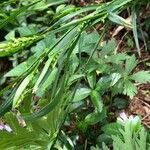Vigorously colonial by creeping rhizomes, 4–9 dm, phyllopodic; main stem-lvs 4–8 mm wide, those of the large sterile shoots to 14 mm wide; staminate spike 2–4 cm, longer than its peduncle; pistillate spikes 3–several, cylindric, 2–4 cm, erect, the lower long-peduncled, the upper progressively less so or subsessile; bracts lf-like, sheathless or nearly so; pistillate scales lanceolate, nearly equaling the perigynia, acuminate or acute; perigynia obovoid, obtusely trigonous,3.2–4.4 mm, minutely scabrous-puberulent, conspicuously 2-ribbed, few-nerved, abruptly narrowed into a somewhat outcurved beak half as long as the body and minutely bidentate; achene concavely trigonous. Moist shaded ground and swamps; N.S. and Que. to Mich., s. to N.J., O., and Mo., and in the mts. to Ga.


